Predictive Analytics Report: Analyzing Group Emotional States
VerifiedAdded on 2022/10/09
|7
|1329
|15
Report
AI Summary
This report analyzes various research studies focused on predicting the emotional state of groups. It examines different approaches, including the EASI model, three-variable models incorporating emotional intelligence and transformational leadership, and agent-based modeling. The report also explores the application of these models in different contexts, such as business, emergency evacuation, and social networks. Key findings include the importance of emotional intelligence, leadership styles, and social network dynamics in influencing group emotions. The report highlights the strengths and weaknesses of each approach, emphasizing the need for further research, particularly in online interactions, to refine and improve the accuracy of predictive models. The studies reviewed include the works of Gerben (2009), Wang & Huang (2009), Stéphane (2014), Bosse et al. (2015), Blankendaal et al. (2016), and Van der Wal et al. (2017), providing a comprehensive overview of the current state of research in this field.
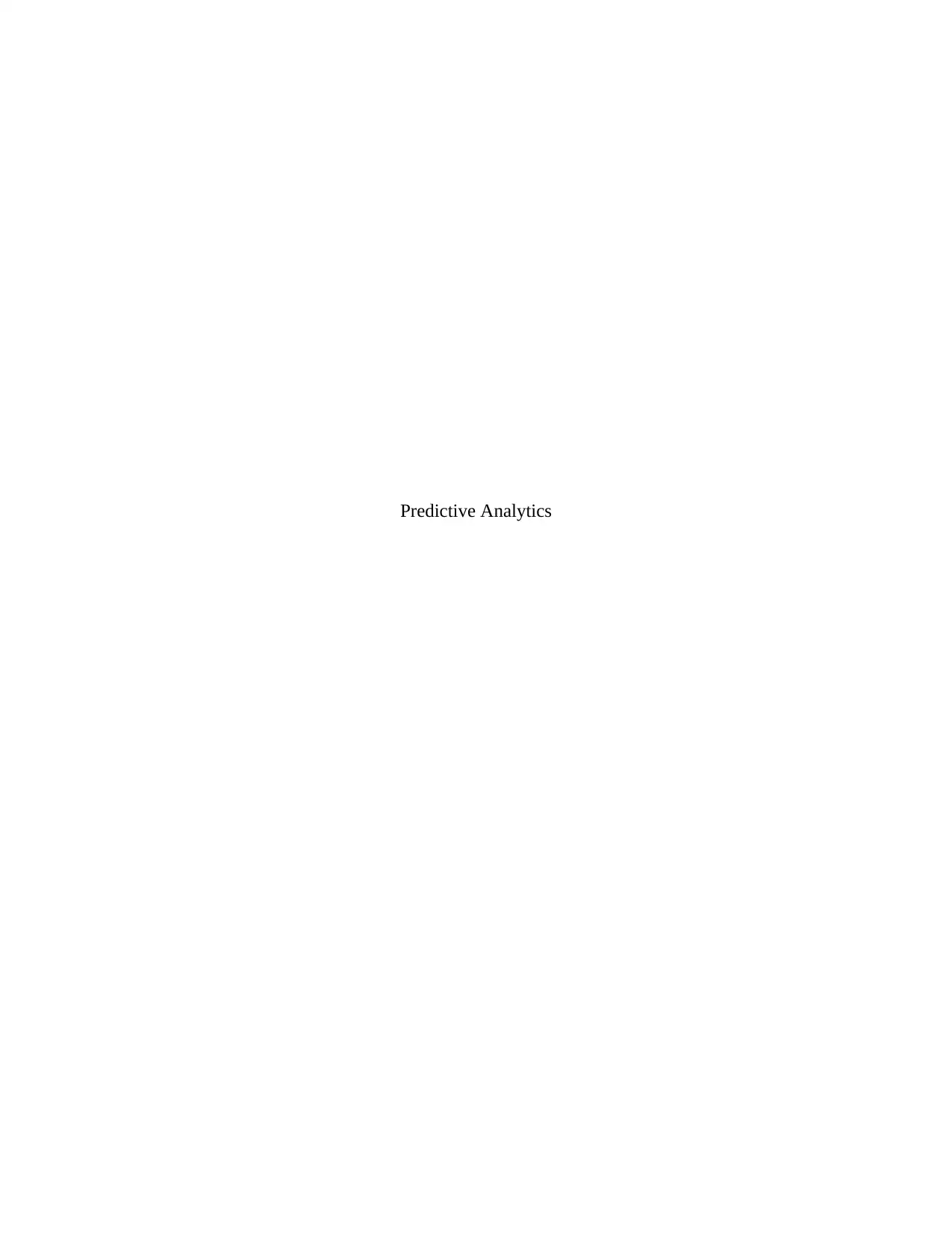
Predictive Analytics
Paraphrase This Document
Need a fresh take? Get an instant paraphrase of this document with our AI Paraphraser
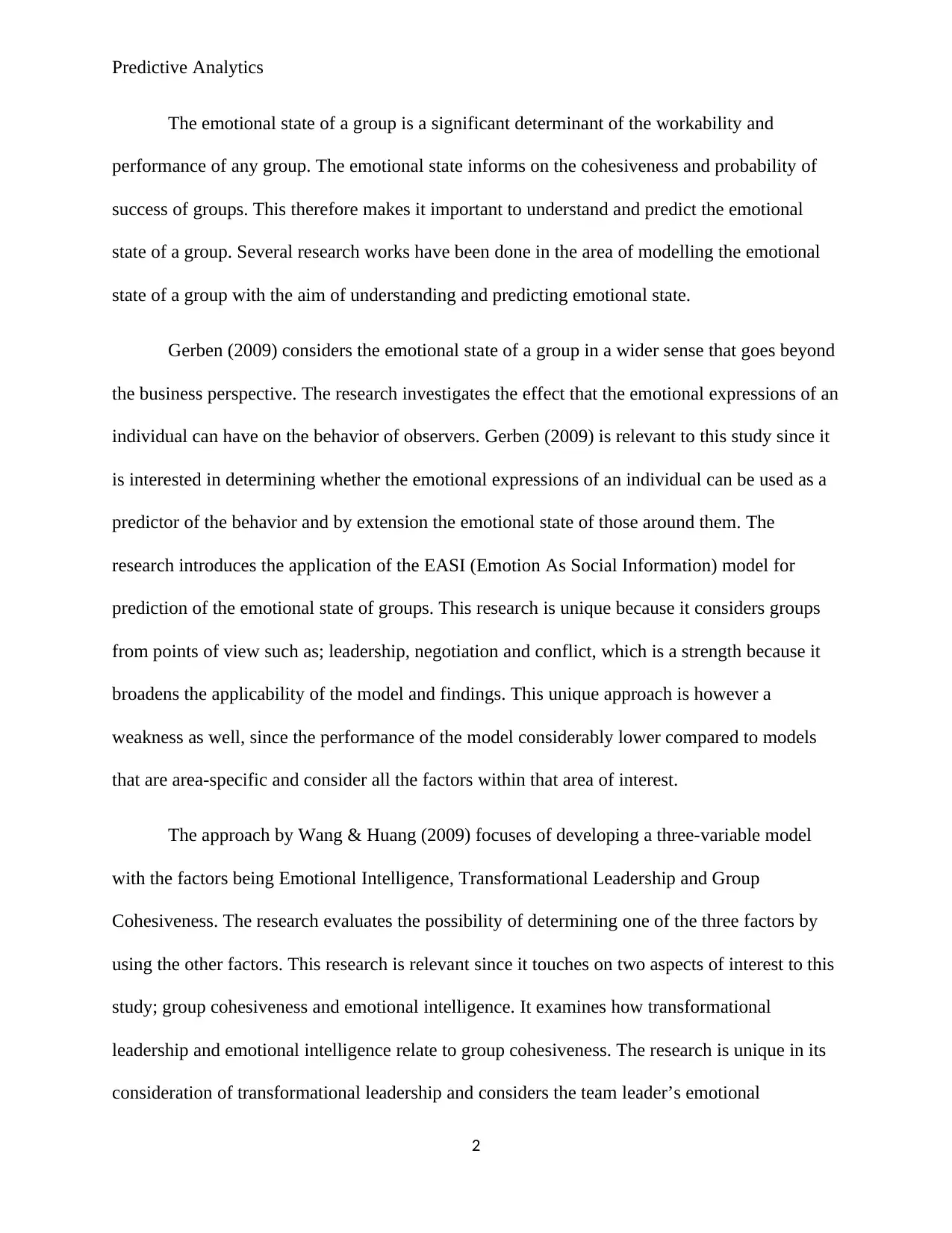
Predictive Analytics
The emotional state of a group is a significant determinant of the workability and
performance of any group. The emotional state informs on the cohesiveness and probability of
success of groups. This therefore makes it important to understand and predict the emotional
state of a group. Several research works have been done in the area of modelling the emotional
state of a group with the aim of understanding and predicting emotional state.
Gerben (2009) considers the emotional state of a group in a wider sense that goes beyond
the business perspective. The research investigates the effect that the emotional expressions of an
individual can have on the behavior of observers. Gerben (2009) is relevant to this study since it
is interested in determining whether the emotional expressions of an individual can be used as a
predictor of the behavior and by extension the emotional state of those around them. The
research introduces the application of the EASI (Emotion As Social Information) model for
prediction of the emotional state of groups. This research is unique because it considers groups
from points of view such as; leadership, negotiation and conflict, which is a strength because it
broadens the applicability of the model and findings. This unique approach is however a
weakness as well, since the performance of the model considerably lower compared to models
that are area-specific and consider all the factors within that area of interest.
The approach by Wang & Huang (2009) focuses of developing a three-variable model
with the factors being Emotional Intelligence, Transformational Leadership and Group
Cohesiveness. The research evaluates the possibility of determining one of the three factors by
using the other factors. This research is relevant since it touches on two aspects of interest to this
study; group cohesiveness and emotional intelligence. It examines how transformational
leadership and emotional intelligence relate to group cohesiveness. The research is unique in its
consideration of transformational leadership and considers the team leader’s emotional
2
The emotional state of a group is a significant determinant of the workability and
performance of any group. The emotional state informs on the cohesiveness and probability of
success of groups. This therefore makes it important to understand and predict the emotional
state of a group. Several research works have been done in the area of modelling the emotional
state of a group with the aim of understanding and predicting emotional state.
Gerben (2009) considers the emotional state of a group in a wider sense that goes beyond
the business perspective. The research investigates the effect that the emotional expressions of an
individual can have on the behavior of observers. Gerben (2009) is relevant to this study since it
is interested in determining whether the emotional expressions of an individual can be used as a
predictor of the behavior and by extension the emotional state of those around them. The
research introduces the application of the EASI (Emotion As Social Information) model for
prediction of the emotional state of groups. This research is unique because it considers groups
from points of view such as; leadership, negotiation and conflict, which is a strength because it
broadens the applicability of the model and findings. This unique approach is however a
weakness as well, since the performance of the model considerably lower compared to models
that are area-specific and consider all the factors within that area of interest.
The approach by Wang & Huang (2009) focuses of developing a three-variable model
with the factors being Emotional Intelligence, Transformational Leadership and Group
Cohesiveness. The research evaluates the possibility of determining one of the three factors by
using the other factors. This research is relevant since it touches on two aspects of interest to this
study; group cohesiveness and emotional intelligence. It examines how transformational
leadership and emotional intelligence relate to group cohesiveness. The research is unique in its
consideration of transformational leadership and considers the team leader’s emotional
2
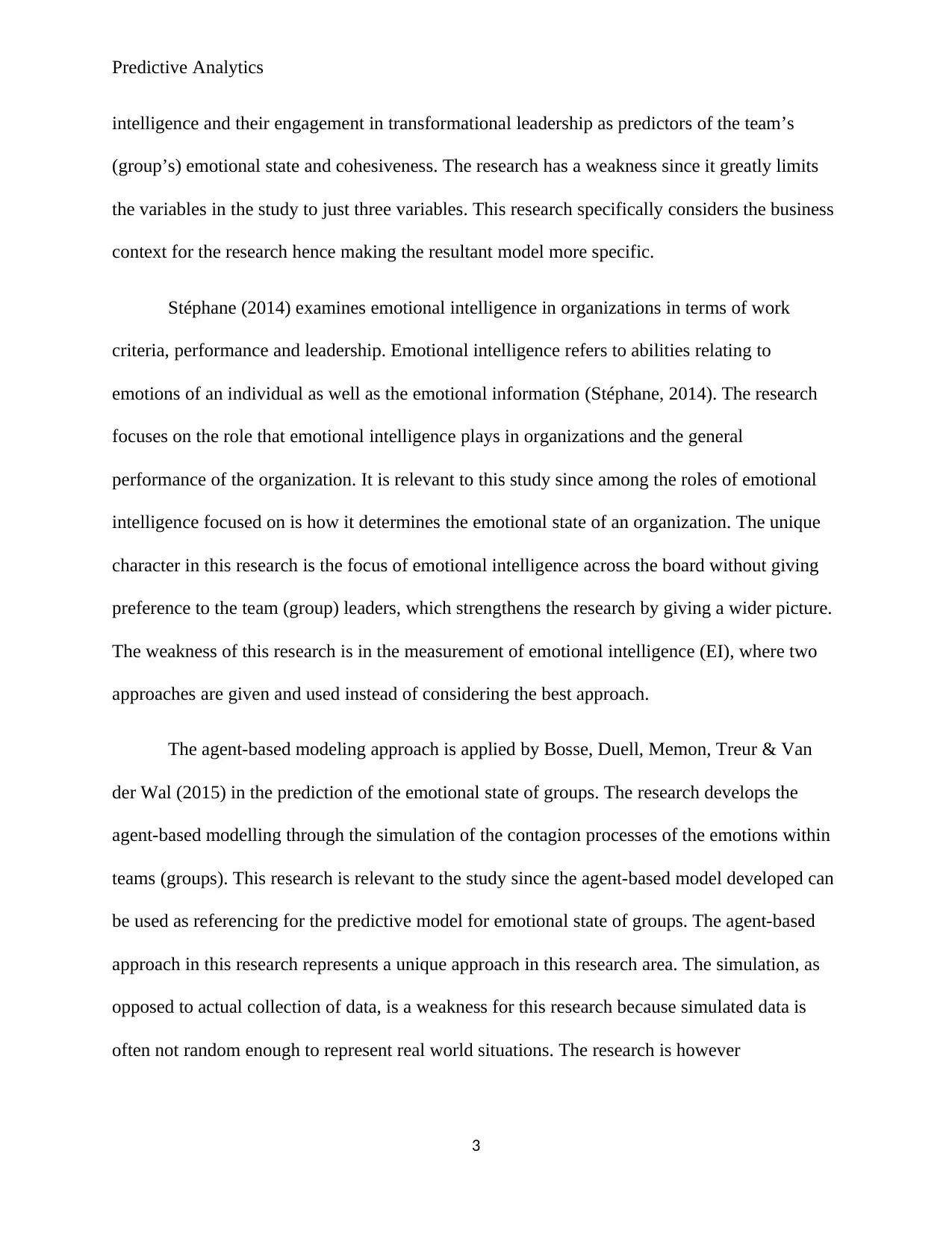
Predictive Analytics
intelligence and their engagement in transformational leadership as predictors of the team’s
(group’s) emotional state and cohesiveness. The research has a weakness since it greatly limits
the variables in the study to just three variables. This research specifically considers the business
context for the research hence making the resultant model more specific.
Stéphane (2014) examines emotional intelligence in organizations in terms of work
criteria, performance and leadership. Emotional intelligence refers to abilities relating to
emotions of an individual as well as the emotional information (Stéphane, 2014). The research
focuses on the role that emotional intelligence plays in organizations and the general
performance of the organization. It is relevant to this study since among the roles of emotional
intelligence focused on is how it determines the emotional state of an organization. The unique
character in this research is the focus of emotional intelligence across the board without giving
preference to the team (group) leaders, which strengthens the research by giving a wider picture.
The weakness of this research is in the measurement of emotional intelligence (EI), where two
approaches are given and used instead of considering the best approach.
The agent-based modeling approach is applied by Bosse, Duell, Memon, Treur & Van
der Wal (2015) in the prediction of the emotional state of groups. The research develops the
agent-based modelling through the simulation of the contagion processes of the emotions within
teams (groups). This research is relevant to the study since the agent-based model developed can
be used as referencing for the predictive model for emotional state of groups. The agent-based
approach in this research represents a unique approach in this research area. The simulation, as
opposed to actual collection of data, is a weakness for this research because simulated data is
often not random enough to represent real world situations. The research is however
3
intelligence and their engagement in transformational leadership as predictors of the team’s
(group’s) emotional state and cohesiveness. The research has a weakness since it greatly limits
the variables in the study to just three variables. This research specifically considers the business
context for the research hence making the resultant model more specific.
Stéphane (2014) examines emotional intelligence in organizations in terms of work
criteria, performance and leadership. Emotional intelligence refers to abilities relating to
emotions of an individual as well as the emotional information (Stéphane, 2014). The research
focuses on the role that emotional intelligence plays in organizations and the general
performance of the organization. It is relevant to this study since among the roles of emotional
intelligence focused on is how it determines the emotional state of an organization. The unique
character in this research is the focus of emotional intelligence across the board without giving
preference to the team (group) leaders, which strengthens the research by giving a wider picture.
The weakness of this research is in the measurement of emotional intelligence (EI), where two
approaches are given and used instead of considering the best approach.
The agent-based modeling approach is applied by Bosse, Duell, Memon, Treur & Van
der Wal (2015) in the prediction of the emotional state of groups. The research develops the
agent-based modelling through the simulation of the contagion processes of the emotions within
teams (groups). This research is relevant to the study since the agent-based model developed can
be used as referencing for the predictive model for emotional state of groups. The agent-based
approach in this research represents a unique approach in this research area. The simulation, as
opposed to actual collection of data, is a weakness for this research because simulated data is
often not random enough to represent real world situations. The research is however
3
⊘ This is a preview!⊘
Do you want full access?
Subscribe today to unlock all pages.

Trusted by 1+ million students worldwide
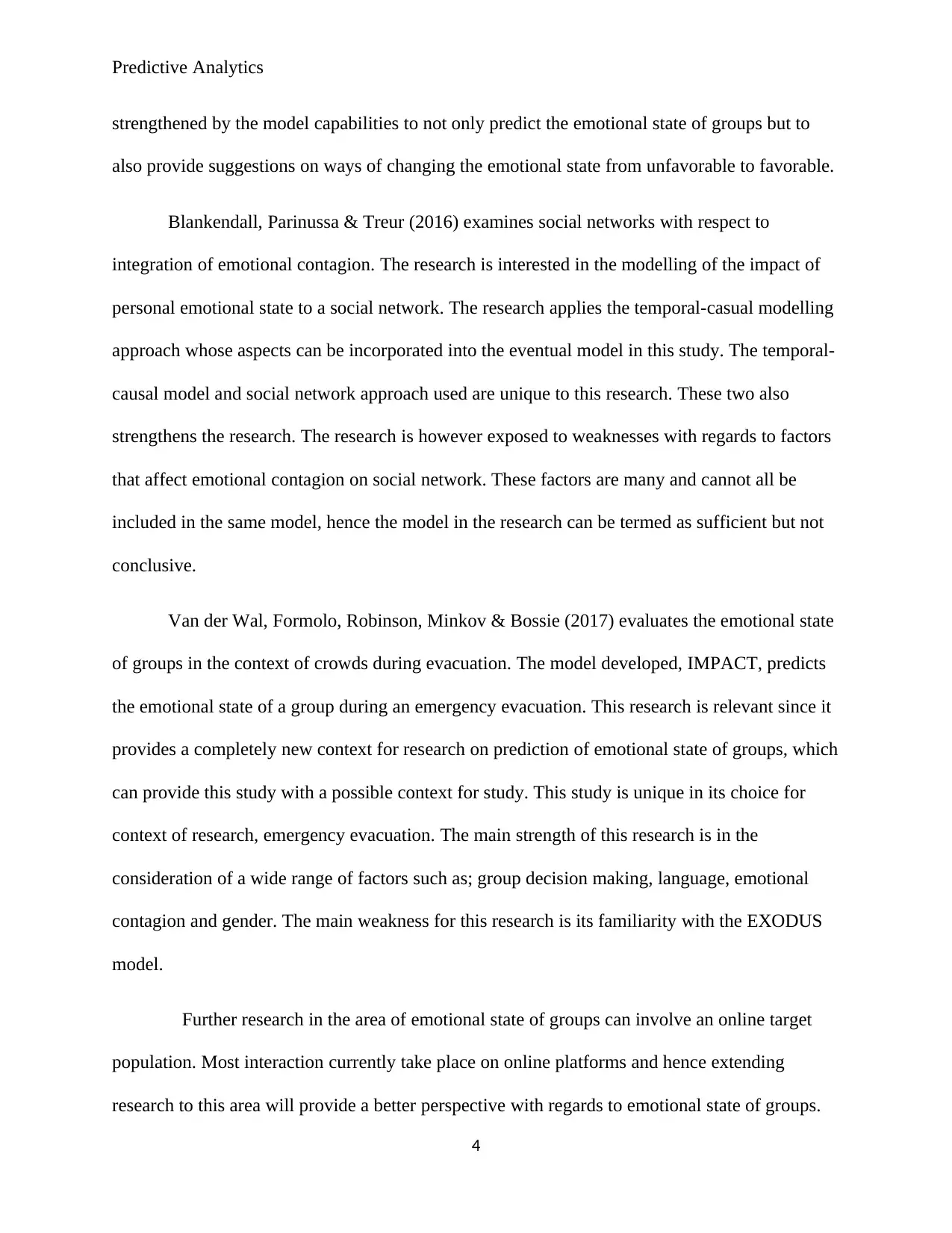
Predictive Analytics
strengthened by the model capabilities to not only predict the emotional state of groups but to
also provide suggestions on ways of changing the emotional state from unfavorable to favorable.
Blankendall, Parinussa & Treur (2016) examines social networks with respect to
integration of emotional contagion. The research is interested in the modelling of the impact of
personal emotional state to a social network. The research applies the temporal-casual modelling
approach whose aspects can be incorporated into the eventual model in this study. The temporal-
causal model and social network approach used are unique to this research. These two also
strengthens the research. The research is however exposed to weaknesses with regards to factors
that affect emotional contagion on social network. These factors are many and cannot all be
included in the same model, hence the model in the research can be termed as sufficient but not
conclusive.
Van der Wal, Formolo, Robinson, Minkov & Bossie (2017) evaluates the emotional state
of groups in the context of crowds during evacuation. The model developed, IMPACT, predicts
the emotional state of a group during an emergency evacuation. This research is relevant since it
provides a completely new context for research on prediction of emotional state of groups, which
can provide this study with a possible context for study. This study is unique in its choice for
context of research, emergency evacuation. The main strength of this research is in the
consideration of a wide range of factors such as; group decision making, language, emotional
contagion and gender. The main weakness for this research is its familiarity with the EXODUS
model.
Further research in the area of emotional state of groups can involve an online target
population. Most interaction currently take place on online platforms and hence extending
research to this area will provide a better perspective with regards to emotional state of groups.
4
strengthened by the model capabilities to not only predict the emotional state of groups but to
also provide suggestions on ways of changing the emotional state from unfavorable to favorable.
Blankendall, Parinussa & Treur (2016) examines social networks with respect to
integration of emotional contagion. The research is interested in the modelling of the impact of
personal emotional state to a social network. The research applies the temporal-casual modelling
approach whose aspects can be incorporated into the eventual model in this study. The temporal-
causal model and social network approach used are unique to this research. These two also
strengthens the research. The research is however exposed to weaknesses with regards to factors
that affect emotional contagion on social network. These factors are many and cannot all be
included in the same model, hence the model in the research can be termed as sufficient but not
conclusive.
Van der Wal, Formolo, Robinson, Minkov & Bossie (2017) evaluates the emotional state
of groups in the context of crowds during evacuation. The model developed, IMPACT, predicts
the emotional state of a group during an emergency evacuation. This research is relevant since it
provides a completely new context for research on prediction of emotional state of groups, which
can provide this study with a possible context for study. This study is unique in its choice for
context of research, emergency evacuation. The main strength of this research is in the
consideration of a wide range of factors such as; group decision making, language, emotional
contagion and gender. The main weakness for this research is its familiarity with the EXODUS
model.
Further research in the area of emotional state of groups can involve an online target
population. Most interaction currently take place on online platforms and hence extending
research to this area will provide a better perspective with regards to emotional state of groups.
4
Paraphrase This Document
Need a fresh take? Get an instant paraphrase of this document with our AI Paraphraser
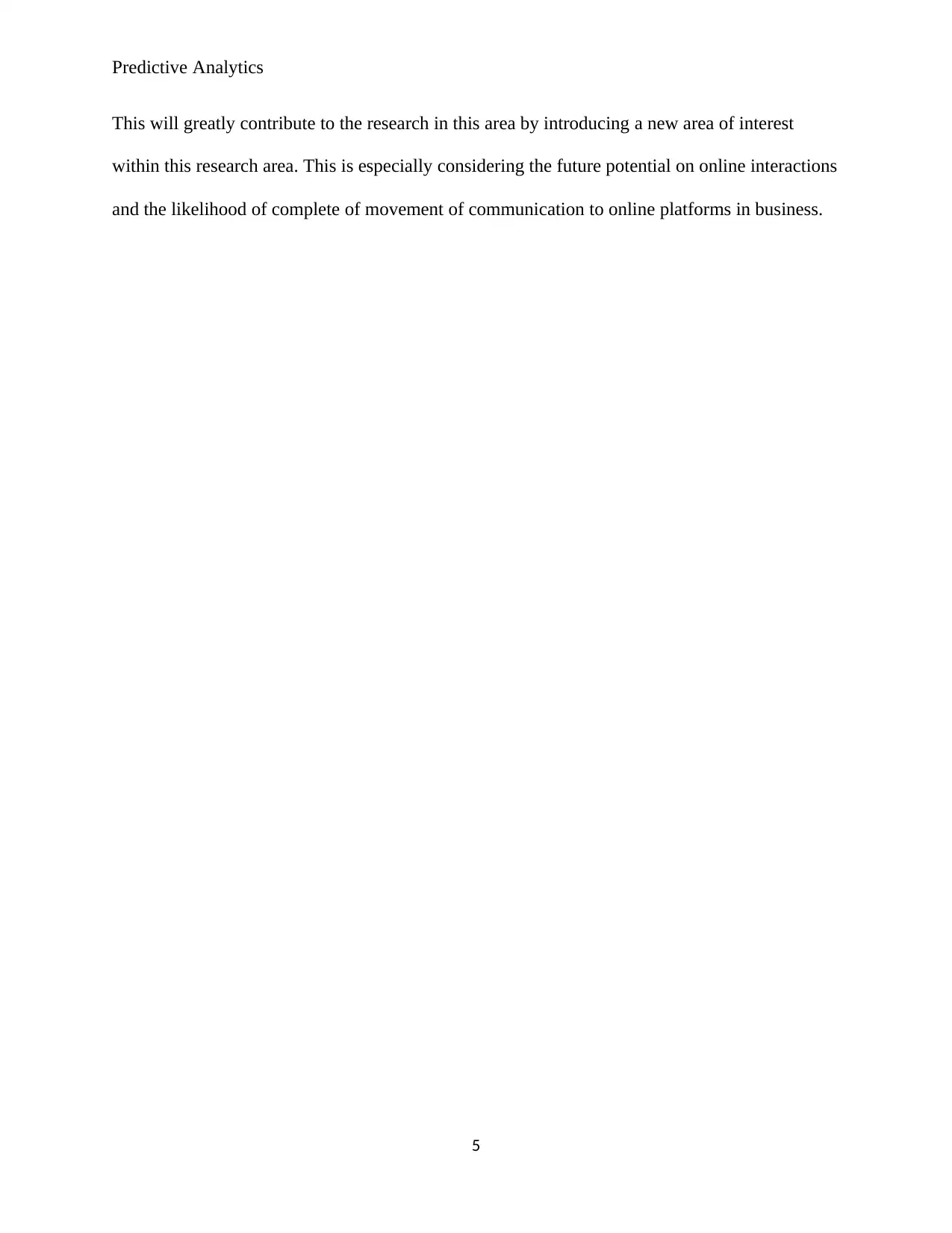
Predictive Analytics
This will greatly contribute to the research in this area by introducing a new area of interest
within this research area. This is especially considering the future potential on online interactions
and the likelihood of complete of movement of communication to online platforms in business.
5
This will greatly contribute to the research in this area by introducing a new area of interest
within this research area. This is especially considering the future potential on online interactions
and the likelihood of complete of movement of communication to online platforms in business.
5
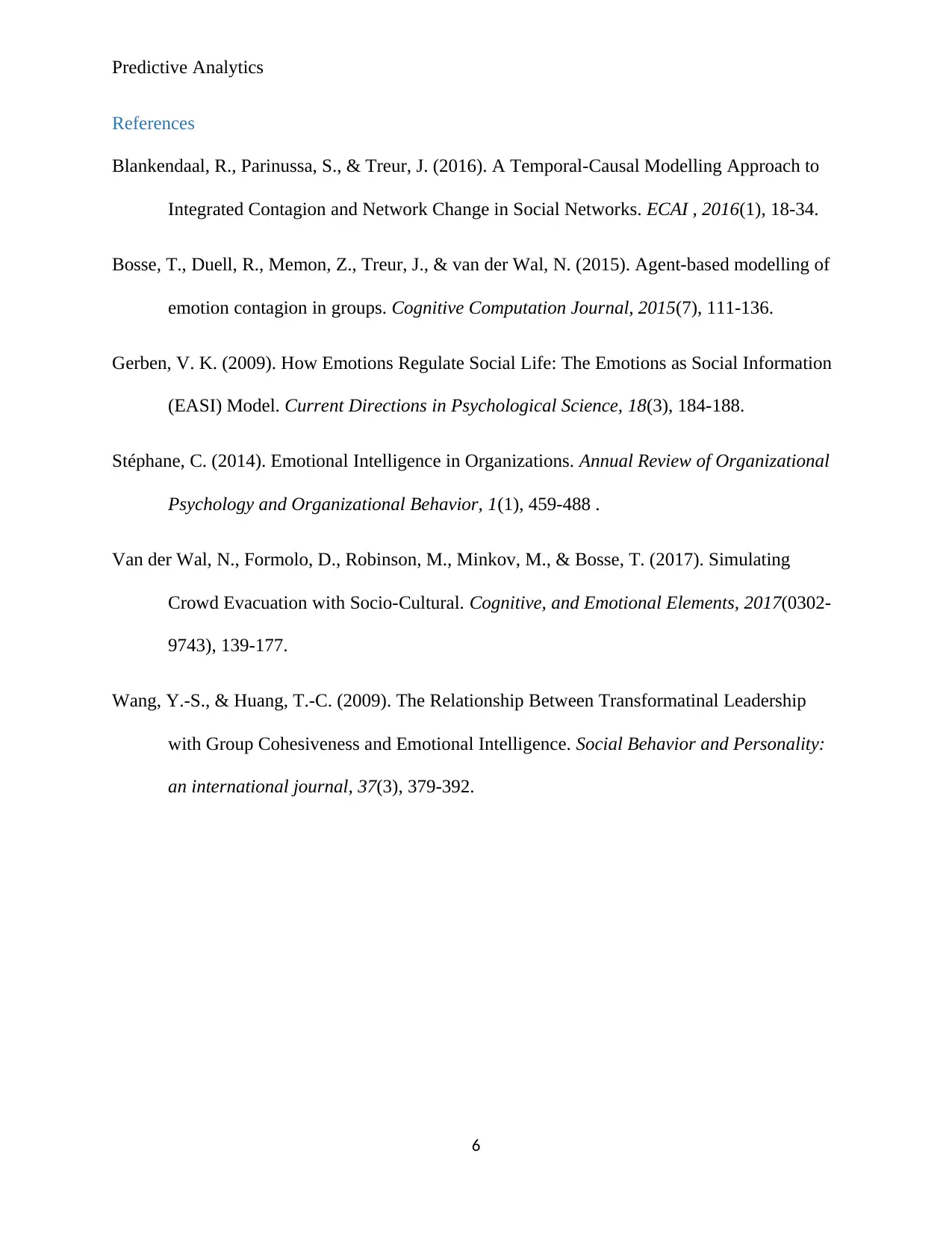
Predictive Analytics
References
Blankendaal, R., Parinussa, S., & Treur, J. (2016). A Temporal-Causal Modelling Approach to
Integrated Contagion and Network Change in Social Networks. ECAI , 2016(1), 18-34.
Bosse, T., Duell, R., Memon, Z., Treur, J., & van der Wal, N. (2015). Agent-based modelling of
emotion contagion in groups. Cognitive Computation Journal, 2015(7), 111-136.
Gerben, V. K. (2009). How Emotions Regulate Social Life: The Emotions as Social Information
(EASI) Model. Current Directions in Psychological Science, 18(3), 184-188.
Stéphane, C. (2014). Emotional Intelligence in Organizations. Annual Review of Organizational
Psychology and Organizational Behavior, 1(1), 459-488 .
Van der Wal, N., Formolo, D., Robinson, M., Minkov, M., & Bosse, T. (2017). Simulating
Crowd Evacuation with Socio-Cultural. Cognitive, and Emotional Elements, 2017(0302-
9743), 139-177.
Wang, Y.-S., & Huang, T.-C. (2009). The Relationship Between Transformatinal Leadership
with Group Cohesiveness and Emotional Intelligence. Social Behavior and Personality:
an international journal, 37(3), 379-392.
6
References
Blankendaal, R., Parinussa, S., & Treur, J. (2016). A Temporal-Causal Modelling Approach to
Integrated Contagion and Network Change in Social Networks. ECAI , 2016(1), 18-34.
Bosse, T., Duell, R., Memon, Z., Treur, J., & van der Wal, N. (2015). Agent-based modelling of
emotion contagion in groups. Cognitive Computation Journal, 2015(7), 111-136.
Gerben, V. K. (2009). How Emotions Regulate Social Life: The Emotions as Social Information
(EASI) Model. Current Directions in Psychological Science, 18(3), 184-188.
Stéphane, C. (2014). Emotional Intelligence in Organizations. Annual Review of Organizational
Psychology and Organizational Behavior, 1(1), 459-488 .
Van der Wal, N., Formolo, D., Robinson, M., Minkov, M., & Bosse, T. (2017). Simulating
Crowd Evacuation with Socio-Cultural. Cognitive, and Emotional Elements, 2017(0302-
9743), 139-177.
Wang, Y.-S., & Huang, T.-C. (2009). The Relationship Between Transformatinal Leadership
with Group Cohesiveness and Emotional Intelligence. Social Behavior and Personality:
an international journal, 37(3), 379-392.
6
⊘ This is a preview!⊘
Do you want full access?
Subscribe today to unlock all pages.

Trusted by 1+ million students worldwide

Predictive Analytics
7
7
1 out of 7
Your All-in-One AI-Powered Toolkit for Academic Success.
+13062052269
info@desklib.com
Available 24*7 on WhatsApp / Email
![[object Object]](/_next/static/media/star-bottom.7253800d.svg)
Unlock your academic potential
Copyright © 2020–2025 A2Z Services. All Rights Reserved. Developed and managed by ZUCOL.

